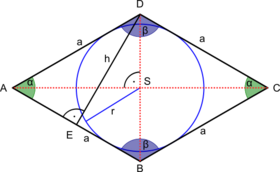Rhombus facts for kids
Quick facts for kids Rhombus |
|
|---|---|
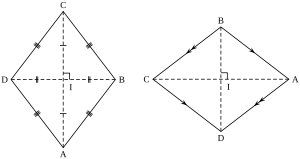
Two rhombi
|
|
| Type | quadrilateral, parallelogram, kite |
| Edges and vertices | 4 |
| Schläfli symbol | { } + { } |
| Coxeter diagram | |
| Symmetry group | Dihedral (D2), [2], (*22), order 4 |
| Dual polygon | rectangle |
| Properties | convex, isotoxal |
A rhombus is a parallelogram with all sides equal in length. A rhombus with all angles equal is called a square.
The word rhombus comes from the Greek word rhombos, meaning "spinning top". A rhombus is sometimes called a diamond, but not all rhombi are diamond shaped.
To find the perimeter of a rhombus, just add up all the sides. Also opposite sides are parallel and opposite angles are equal.
Another interesting thing is that the diagonals (dashed lines in second figure) meet in the middle at a right angle.
Contents
Characterizations
A simple (non-self-intersecting) quadrilateral is a rhombus if and only if it is any one of the following:
- a parallelogram in which a diagonal bisects an interior angle
- a parallelogram in which at least two consecutive sides are equal in length
- a parallelogram in which the diagonals are perpendicular (an orthodiagonal parallelogram)
- a quadrilateral with four sides of equal length (by definition)
- a quadrilateral in which the diagonals are perpendicular and bisect each other
- a quadrilateral in which each diagonal bisects two opposite interior angles
- a quadrilateral ABCD possessing a point P in its plane such that the four triangles ABP, BCP, CDP, and DAP are all congruent
- a quadrilateral ABCD in which the incircles in triangles ABC, BCD, CDA and DAB have a common point
Basic properties
Every rhombus has two diagonals connecting pairs of opposite vertices, and two pairs of parallel sides. Using congruent triangles, one can prove that the rhombus is symmetric across each of these diagonals. It follows that any rhombus has the following properties:
- Opposite angles of a rhombus have equal measure.
- The two diagonals of a rhombus are perpendicular; that is, a rhombus is an orthodiagonal quadrilateral.
- Its diagonals bisect opposite angles.
The first property implies that every rhombus is a parallelogram. A rhombus therefore has all of the properties of a parallelogram: for example, opposite sides are parallel; adjacent angles are supplementary; the two diagonals bisect one another; any line through the midpoint bisects the area; and the sum of the squares of the sides equals the sum of the squares of the diagonals (the parallelogram law). Thus denoting the common side as a and the diagonals as p and q, in every rhombus
Not every parallelogram is a rhombus, though any parallelogram with perpendicular diagonals (the second property) is a rhombus. In general, any quadrilateral with perpendicular diagonals, one of which is a line of symmetry, is a kite. Every rhombus is a kite, and any quadrilateral that is both a kite and parallelogram is a rhombus.
A rhombus is a tangential quadrilateral. That is, it has an inscribed circle that is tangent to all four sides.
Diagonals
The length of the diagonals p = AC and q = BD can be expressed in terms of the rhombus side a and one vertex angle α as
and
These formulas are a direct consequence of the law of cosines.
Inradius
The inradius (the radius of a circle inscribed in the rhombus), denoted by r, can be expressed in terms of the diagonals p and q as
or in terms of the side length a and any vertex angle α or β as
Area
As for all parallelograms, the area K of a rhombus is the product of its base and its height (h). The base is simply any side length a:
The area can also be expressed as the base squared times the sine of any angle:
or in terms of the height and a vertex angle:
or as half the product of the diagonals p, q:
or as the semiperimeter times the radius of the circle inscribed in the rhombus (inradius):
Another way, in common with parallelograms, is to consider two adjacent sides as vectors, forming a bivector, so the area is the magnitude of the bivector (the magnitude of the vector product of the two vectors), which is the determinant of the two vectors' Cartesian coordinates: K = x1y2 – x2y1.
Dual properties
The dual polygon of a rhombus is a rectangle:
- A rhombus has all sides equal, while a rectangle has all angles equal.
- A rhombus has opposite angles equal, while a rectangle has opposite sides equal.
- A rhombus has an inscribed circle, while a rectangle has a circumcircle.
- A rhombus has an axis of symmetry through each pair of opposite vertex angles, while a rectangle has an axis of symmetry through each pair of opposite sides.
- The diagonals of a rhombus intersect at equal angles, while the diagonals of a rectangle are equal in length.
- The figure formed by joining the midpoints of the sides of a rhombus is a rectangle, and vice versa.
Cartesian equation
The sides of a rhombus centered at the origin, with diagonals each falling on an axis, consist of all points (x, y) satisfying
The vertices are at  and
and  This is a special case of the superellipse, with exponent 1.
This is a special case of the superellipse, with exponent 1.
Other properties
- One of the five 2D lattice types is the rhombic lattice, also called centered rectangular lattice.
- Identical rhombi can tile the 2D plane in three different ways, including, for the 60° rhombus, the rhombille tiling.
| As topological square tilings | As 30-60 degree rhombille tiling | |
|---|---|---|
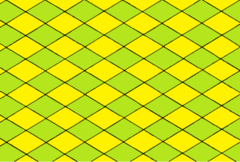 |
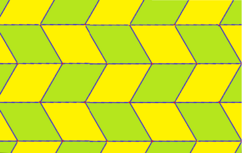 |
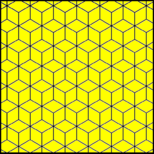 |
- Three-dimensional analogues of a rhombus include the bipyramid and the bicone as a surface of revolution.
See also
 In Spanish: Rombo para niños
In Spanish: Rombo para niños



